F&B
Sunday, 5 March 2017
Sunday, 26 February 2017
Food and Beverage Manager job description
Food and Beverage Manager job description
CATEGORIES
This Food and beverage manager job description template is optimized for posting in online job boards or careers pages. It is easy to customize for your company, restaurant or hotel. As your company hires food and beverage managers (F&B managers) and directors, feel free to change these key duties to fit your needs.
Food and Beverage Manager Responsibilities
Include:
- Managing all F&B and day-to-day operations within budget and to the highest standards
- Ensuring excellent levels of internal and external customer service
- Leading F&B team by attracting, recruiting, training and appraising talented personnel
- Establishing targets, KPI’s, schedules, policies and procedures

Job brief
We are looking for a professional food and beverage manager to be responsible for managing all F&B operations and for delivering an excellent guest experience. The successful candidate will be able to forecast, plan and manage all F&B orders, staff and finance. The goal is to maximize sales and revenue through customer satisfaction and employee engagement.
Responsibilities
- Manage all F&B and day-to-day operations within budgeted guidelines and to the highest standards
- Preserve excellent levels of internal and external customer service
- Design exceptional menus, purchase goods and continuously make necessary improvements
- Identify customers needs and respond proactively to all of their concerns
- Lead F&B team by attracting, recruiting, training and appraising talented personnel
- Establish targets, KPI’s, schedules, policies and procedures
- Provide a two way communication and nurture an ownership environment with emphasis in motivation and teamwork
- Comply with all health and safety regulations
- Report on management regarding sales results and productivity
Requirements
- Proven food and beverage management experience
- Working knowledge of various computer software programs (MS Office, restaurant management software, POS)
- Ability to spot and resolve problems efficiently
- Mastery in delegating multiple tasks
- Communication and leadership skills
- Up to date with food and beverages trends and best practices
- Ability to manage personnel and meet financial targets
- Guest-oriented and service-minded
- Culinary school diploma or degree in food service management or related field
13 couse French classical menu
- 1. French Classical Menu:A menu represents the range of food and beverage items offered in a restaurant. When the menu isrepresented on a card, it is referred to as menu card. Great pains are taken compiling the menu cardwhich should not be attractive but informative. In restaurant basically two types of menu areavailable, a-la-carte and table-de-hote.The French classical menu consists of 12 courses but in some organization follows 17 courses. They areas follows.Twelve courses of French Classical Menu Seventeen courses of French Classical MenuHors-d’-oeuvres (Appetizer) Hors-d’-oeuvre (Appetizer)Potage (Soup) Potage (Soup)Poisson (Fish) Oeufs (egg)Entrée (First Course Of Meat Item) Farineaux (Rice & Pasta)Releve’ (Big Meat Item) Poisson (Fish)Sorbet (Rest Course) Entrée (First Course Of Meat Item)Roti (Roasted meat items) Releve’ (Big Meat Item)Legumes (vegetable) Sorbet (Rest Course)Entremets (Sweet Course) Roti (Roasted meat items)Savoureaux (savory item) Legumes (vegetable)Dessert (Fruit item) Salades (salad)Café (coffee) Buffet froid (cold buffet) Entremets (Sweet Course) Savoureaux (savory item) Fromage (Cheese) Dessert (Fruit item) Café (coffee)Hors-d’-oeuvres (Appetizer)Traditionally the Hors-d’-oeuvres are the selection of salad, fish, and meat. The Hors-d’-oeuvres aregenerally served in cold fish plate along with fish knife and fish fork. Hors-d’-oeuvres are classifiedinto two categories. 1) General Hors-d’-oeuvres General Hors-d’-oeuvres: Different varieties of salad and canapés comes under General Hors- d’-oeuvres. Salad: salad can be plain or compound. Example of plain salad includes fish or meat salad, potato salad, beet root salad, red cabbage salad, cauliflower salad. Compound salad includes for example Russian salad, Andalouse salad etc. Salads are taken in half plate along with fish fork or small fork. Canapés: These are slices of bread with crust removed, cut into small variety of shapes toasted or fried in oil or butter and then garnished. Garnishes include smoked salmon, prawns, cheese, tomato, egg, salami and others various meats.
- 2. Classical Hors-d’-oeuvres: This following item comes under this category. Caviar: Roe of sturgeon fish. Approximately 30gm of caviar is served per portion. The caviar jar /tinare surrounded with crushed ice in a container. Accompaniment includes hot breakfast toast, butter,segments of lemon, chopped shallots, chopped egg yolk & white. Cover will be cold half plate alongwith caviar knife or side knife, which will be placed on the right hand side of the cover. Melon: There are various types of melon. Cantaloupe:It has rough rigid skin with green lines. It is soft and color is yellow.Honeydew:It has a firm, shiny, wrinkled skin with sweet pulp.Watermelon:
- 3. It has red sweet pulp and black seeds. Melons are cut into small portions and served ice cold, on acold half plate along with dessert spoon and fork. Melons are served with Castor sugar and groundginger.Fruit juice:usually served in juice glass or in hi-ball glass. Here we can serve the different varieties of juice such asTomato, orange, mango, Pineapple etc. when we are serving juice to the guest, on that time weshould provide castor sugar as accompaniments of juice. One tea spoon is places on table, to aidmixing. Tomato juice are served with Worcestershire sauce.Oyster:Cold oysters are usually served in cold half plate on the bed of crushed ice. An oyster fork is usuallyoffered but in the absence of oyster fork, a small dessert fork can also be placed on table. Oysters areusually eaten by holding the cell in one hand and fork in the other hand. The finger bowl and extra serviette should be offered because oysters are taken by hand. Accompaniments of oyster include half a lemon, oyster cruet (cayenne pepper, pepper mill, chilly vinegar and tobacco sauce), Brown bread and butter. Potted shrimps:Served in fish plate along with fish knife & fish fork. Accompaniments include hotunbuttered breakfast toast and lemon. Pealed shrimps are cooked in butter and garnished withlettuce leave.
- 4. Smoked Salmon:Served in fish plate along with fish knife & fish fork. Accompaniments include half lemon wedge,brown bread, butter, chopped onion etc.Snail (escargots):Snail tongs are placed on the left and snail fork on the right. They are served with bread, butter,lemon etc.Sea food cocktail:They are served in champagne saucer glass and saucer can be used as under liner. During the time ofservice we should provide tea spoon and fish fork. Accompaniments include brown bread, butter,lemon wedge etc.Potage (soup): This is the second course of French Classical menu. Soup is liquid, nutritious food made of meat, sea food, vegetable, cereals, poultry etc. Soups are classified under two categories.
- 5.SOUP…………………………………………………………………………………………………………………………Thin Soup Thick SoupConsommé PureeBroth Cream Chowder Bisque VelouteThin SoupConsommé It is a richly flavored clear soup. The base is stock of beef; mutton or chicken to which raw,lean mince meat is added along with finely diced or chopped carrots, onions, celery seasoning and eggwhites. It is brought to boil and simmered. The protein in the egg white and meat, coagulate and bindmost of the cloudy material. The soup is strained through a muslin cloth.Consommé is served in double handled consume cup along with under liner & dessert spoon.Examples of ConsomméConsommé cereals, Consommé Julienne, Consommé egg drop, Consommé royal.Broth: Broth is a cloudy soup which contains a mixture of vegetables, meat, chicken, etc.Thick Soup 1) Purée Soup: These are pulp of vegetable, like carrot, peas, spinach, tomatoes, potatoes etc. Examples are Tomato soup, pea soup etc. 2) Veloute: This is prepared by a blend of blond roux and white stock with a few base vegetables for flavoring. 3) Cream Soup: These are blend of Béchamel sauce with the purees of vegetable, meat etc. Milk may be added to dilute and give an even consistency. Example: cream of tomato soup, cream of mushroom soup, Cream of asparagus soup. These soups are taken with bread roll /bread stick & butter. 4) Chowder: These are heavy thick soup of America. Their bases are Tomato or milk with sea food , onion, potatoes, bacon , various seasoning for flavor etc.
- 6. 5) Bisque: It is a thick, creamy, highly-seasoned soup of French origin. It can be Made from lobster, crab, shrimp or crayfish.Tips for the service of soup1. Garnishing must be small, light and easily eatable.2. Light soups should precede heavy dishes.3. Heavy soups must come in small portions.4. Hot soups must be served very hot, and cold soups chilled.5. Clear soups must enable you to see the bottom of the soup bowl.6. Soup accompaniments are toasts, breadsticks, cheese croutons, etc. These must be hot and crisp.7. Soup is served in soup bowl along with an under liner and soup spoon.Oeufs (egg): This is the third course of French classical menu. Different varieties of omelette, boiled egg,poached egg, fried eggs are served in this course. Omelets, poached eggs are served in half plate alongwith small knife and fork and boiled eggs are served in egg cups.Omelette espagnole- flat Omelette with onions, peppers and tomato.Omelette fines herbes- Savory OmeletteOeufs en cocotte a la crème- egg cooked in its own dish in a Bain Marie& garnished with cream.Oeuf poche Florentine- poached egg on a bed of spinach, coated with aCheese sauce.Farineaux (PASTA AND RICE DISHES): This is the fourth course French classical menu. Pasta meansdough & is originated from Italy. Different types of pastas are available in the market. Such as Spaghetti,Fettuccini, macaroni. Penne, Rigatoni etc. SpaghettiSpaghetti Napolitano- spaghetti in a tomato and garlic flavored sauce.Spaghetti bolognaise- spaghetti blended with minced lean beef in a rich brown sauce.Poisson (Fish): This is the fifth course of French classical menu. In this course the fish items are served.The fish may be fried, poached or grilled. Fish is served in either fish plate or half plate along with fishknife and fish fork. The method of cooking and type of fish used may vary. Few methods are as follow:Poached: Salmon, Turbot, and Trout etc.Cooked meuniere: (Sautéed Fish with Butter, Lemon & Parsley) sole, trout, salmonFried: whitebait, soleSome examples are:Sole meuniere- sole shallow fried in butter
- 7. Sole Colbert- sole flour, egg and bread crumbed (pane) and deep-fried; the fillets are rolled back of thebackbone in preparations.Grilled fish with lemon butter sauce.Poisson poached Hollandaise.Fried fishFillet de Poisson Duglere. (Duglere is a type of sauce made of butter, minced onion, flour, tomato,lemon juice, two table spoon white wine, milk, salt, pepper etc)ENTRÉE :( First meat course) This is the sixth course of French classical menu. Entree is generally smallwell garnished dishes which come from kitchen. They are usually accompanied with rich sauce andgravy. In this course foods are served in half plate along with small knife and fork.Examples of entrée are:Poulet sauté chasseur- sauté chicken in a rich brown sauce flavored with tomato and mushroom.Supreme de volaille (poultry) a la king- breast and wing of chicken cooked under a cover in oven.Emincee de volaille a la king- Minced chicken with Savory rice.Steak Diane- minute steak shallow fried and flavored with onion and mushroom; sauce finished with redwine or cream.Fillet/rump steak grille- fillet/rump steak grilled and garnished with tomato, mushroom, watercress and straw potato. Chautebriand- double fillet steak grilled Vol-au-vent: it is a small hollow case of puff pastry. Vol-au-vents can accommodate various fillings, such as mushrooms, prawns, fruit, or cheese.RELEVE: (main meat course) this is the seventh course of French classical menu. Releve are normallylarger than entrees and take the form of butchers’ joints, which have to be carved. These joints areeither poeled or roasted. A sauce or roast gravy and potatoes and green vegetables are always servedwith this course.The main dish may consist of any of the following items: saddle of mutton,Baron of beef, boned sirloin, braised ham. This course is served in full plate along with large knife andfork.Examples are: C ontrefilet de boeuf roti a l’anglaise: boned and roasted sirloin of beef. C uissot de porc roti, puree de pommes: roast leg of pork with apple sauce. C arre d’agneau roti: roast best end of lamb.Sorbet: (rest course) this is the eighth course of French classical menu. This is actually the rest course.After serving fish and meat, this course is been served.Normally in this course a glass of iced chilled water flavored with few drops of champagne or brandy canbe served. This course is normally served in water goblet along with an under liner. Cigar or cigarettecan also be served in this course. Normally this course contains 10-15 minutes.ROTI (Roasted meat item) this course signifies poultry, and game birds such as chicken, duck, turkey etc.This is the nineth course of French classical menu. These roasted items are accompanied with differenttypes of sauces (apple sauce, cranberry sauce), herbs (sage), onion stuffing, nicely chopped salad, roastgravy, brown bread and butter etc. This course is always served in full plate along with large knife andfork.
- 8. Legumes (vegetable) in this course the dressed or cooked vegetables such as Asparagus, Broccoli,Cauliflower, green peas, mushroom, spinach are served with Hollandaise or Mayonnaise sauce. . Forvegetable we have to provide small knife and fork. For asparagus no cutlery is used because asparagus istaken by hand and that is why finger bowl needs to be provided to clean hands.Examples are:Puree de pommes- creamed potatoesPommes persille- boiled potatoes, coated with melted butter and sprinkled with chopped parsley. Pommes au four- baked jacket potato Petits pois au beurre- peas tossed in butter. Epinards en branches- leaf spinach Champignons grille- grilled mushrooms Choufleur morney- cauliflower with cheese sauce Celeries braises- braised celery Asperges en branche, sauce hollandaise- asparagus accompanied by an egg- and butter based sauce. Haricots verts au beurre- French beans tossed in butter.Salades(salad) a dish of raw or cold cooked foods, usually dressed and seasoned, served as an Hors-d’-oeuvres or side dish.Example of salads is:Salade francaise: lettuce, tomato, egg and vinaigrette dressing.Salade vert: lettuce, watercress, cucumber and green pepper.Buffet froid (cold buffet) the examples of cold buffet is as followsJuice, shrimp cocktail, cold slawCold consomméEgg mayonnaiseChicken saladSmoked venisonIced chilled water with few drops of champagneGateaux, caramel CustardEntremets (Sweet Course) in these course different types of cold and sweet items such as pudding,mousse, soufflé, ice creams are served. They are normally served in half plate along with dessert spoonand fork. In case of ice cream, it is served in ice cream cup along with under liner and ice cream spoon.Parfait ice cream is served in parfait glass, with under liner and parfait spoon.
- 9. THE EXAMPLES ARE: C repe Suzette: pancakes in a rich fresh orange juice and grand Marnier (It is made from a blend of truecognacs and distilled essence of bitter orange.) - flavored sauce and flamed with brandy. A nanas flambé au kirsch: pineapple flamed with a cherry-flavored liqueur. V ariety of cold sweets presented from the cold platter, trolley, such as Gateaux, or ice-cream sweets.Savoureaux (savory item) before dessert a savory is provided to change the sweetness of tongue.Savoureaux may be of three types. a) Fish savory: Example Tuna on toast, served in half plate along with fish knife and fish fork. b) Meat savory: Example chicken liver on toast, served in half plate along with small knife and fork. c) Cheese savory: Cheese is generally served in half plate along with cheese knife. A cheese platter which contains a different varieties of cheese, are presented in front of the guest and the guest picks up the cheese as per his choice. Cheese is served with cream cracker biscuit and celery sticks.Fromage (Cheese) all types of cheese may be offered together with the appropriate accompaniments.The ideal cheese board should combine hard, semi-hard, soft or cream, blue and fresh cheese.Examples:Name of cheese Type Place of originCheddar hard EnglandRed Cheshire hard HollandBrie soft FranceGorgonzola blue ItalyDemi-sel soft FranceGouda hard HollandRicotta fresh ItalyDessert (Fruits) in this course fresh fruits is served in fruit basket along with fruit fork. Cut fruits can beserved in half plate; otherwise the fruits are normally served in fruit basket. During the time of servingfruit basket, one serviette and two finger bowls, one containing lukewarm water and containing coldwater should be provided to the guest. The bowl containing lukewarm water is provided to wash handand cold water is provided to wash the fruits.Café (coffee) this is the last course of French classical menu. After dinner a strong black coffee is servedin demitasse cup.
Sunday, 19 February 2017
Foodservice Equipment
Foodservice Equipment and Supplies Distributors
SIC 5046 | NAICS 423440
The following guide to industry information, research, and analysis provides sources for industry trends and statistics, financial ratios, salary surveys, and more.
Select from the following sections or scroll below to view available resources:
Industry Analysis, Statistics, Trends, and Forecasts
Financial Information and Financial Ratios
Compensation and Salary Surveys
Business Valuation Resources
Furniture in F&B Services
The equipment forms an inevitable part of food and beverage service. It plays an important role to build the mood of the guests, to complement the outlet theme, and to elevate guest experience. Right from the largest commodities used for food preparation and interior decoration such as chandeliers or ovens to the smallest piece of cutlery, furniture, or linen participate in creating overall ambience of the outlet.
Let us discuss in detail the equipment used in food and beverage services −
Furniture in F&B Services
Furniture is an important part of any F&B Services outlet. It needs to be strong, easy to use and clean. The furniture plays an important role in bringing the look and creating an ambience of the outlet. The furniture, fixtures, and fittings are fixed commodities.
Indoor Furniture
It mainly consists of tables, chairs, push-down chairs, racks, and lockers.
Outdoor Furniture
It needs to be sturdy as well as attractive. It includes coffee tables and chairs, bar chairs, dining sets, day beds, loungers, hammocks, and swings.
Fixtures and Fittings
A fixture is any item bolted to the floor or walls. For example, air conditioners, electric plugs, sinks and toilets, art pieces, and television screens mounted on wall are fixtures.
A fitting is any free standing item or an item that can be hung by a nail or hook. For example, paintings, mirrors, curtain rails, and lamps are fittings.
Tableware in F&B Services
Tableware consists of crockery, cutlery, glassware and linen used while serving and eating meals at a table. These are circulating equipment which can be grouped into the following types −
Chinaware
This is a collection of fine dishes, bowls, food platters, section dishes, ramekins, cups and saucers, soup spoons, vases, and ash trays made using a translucent ceramic material.
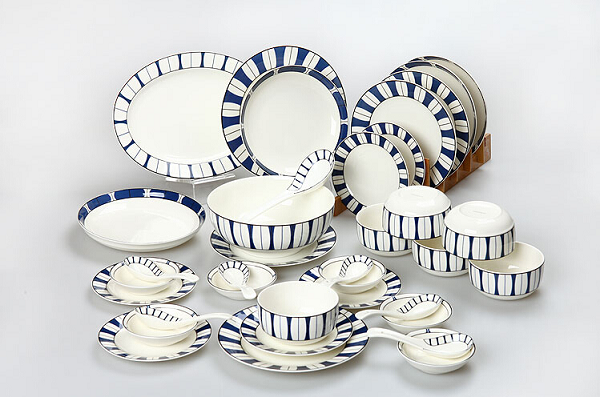
Hollowware
This consists of containers such as serving bowls, pots, kettles, ice jugs, and water. These containers are either made from glass or metals such as copper, brass, or stainless steel.
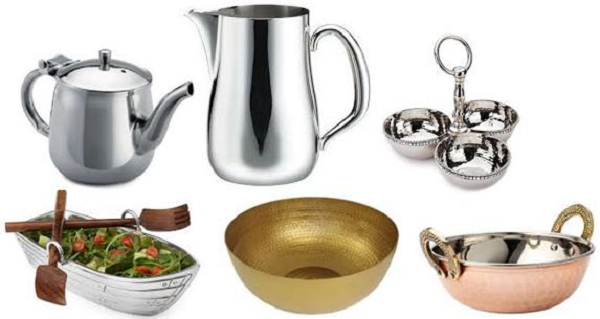
Glassware
This consists of articles made of fine glass. Glassware includes jugs, pitchers, drinkware, ash trays, vases, and similar articles.
Silverware
The objects in silverware are made of Electro Plated Nickel Silver (EPNS). These are made from an alloy of brass, zinc, stainless steel or nickel with silver plating of 10 to 15 microns. Silverware includes spoons, forks, knives, hollowware, drinkware, tongs, ice bucket, and a salver.
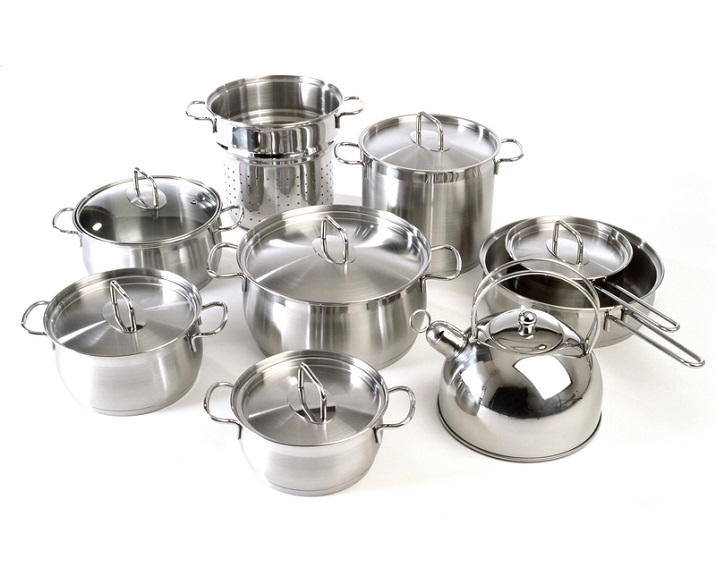
Chaffing Dishes (Chafers)
These are food warming dishes. They keep the food warm for an adequate time and temperature. They come in two variants: electric or chafer fuel candle.
Food and Beverage Services in Hotel
The food and beverage service is part of the service-oriented hospitality sector. It can be a part of a large hotel or tourism business and it can also be run as an independent business. The members of the F&B Services team are required to perform a wide range of tasks which include preparation for service, greeting the guests, taking their orders, settling the bills, and performing various other tasks after the guests leave.
Let us see the F&B services in hotels, structure of F&B department and ancillary services in a hotel.
Food and Beverage Services in Hotel
Most of the star-ranked hotels offer multiple F&B services in their hotels. They can be −
- Restaurant
- Lounge
- Coffee Shop
- Room Service
- Poolside Barbecue/Grill Service
- Banquet Service
- Bar
- Outside Catering Service
Structure of F&B Services Department
The F&B Services personnel are responsible to create the exact experience the guests wish for. The department consists of the following positions −
Food & Beverage Service Manager
The Food & Beverage Service Manager is responsible for −
- Ensuring profit margins are achieved in each financial period from each department of F&B service.
- Planning menus for various service areas in liaison with kitchen.
- Purchasing material and equipment for F&B Services department.
Assistant Food & Beverage Service Manager
The Assistant Food & Beverage Service Manager is aware of and is tuned to all the work the F&B Services Manager performs and carries out the same in the absence of his superior.
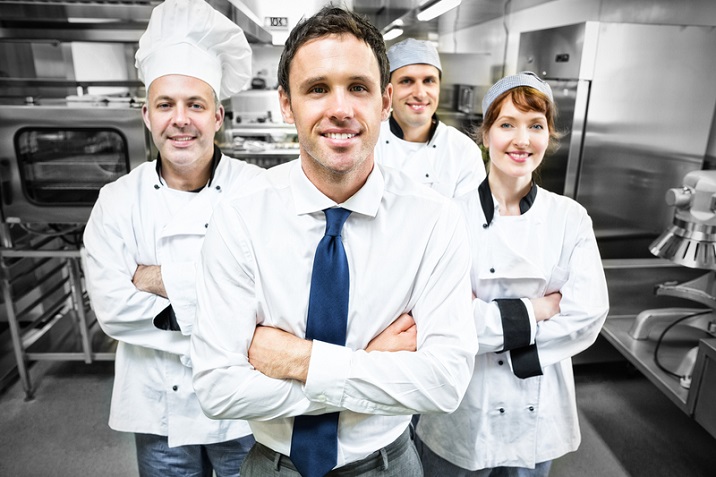
Restaurant Manager
The Restaurant Manager looks after the overall functioning of a restaurant. The responsibility of this staff member include −
- Managing the functions in the dining room
- Ordering material
- Stock-taking or inventory checking.
- Supervising, training, grooming, and evaluating the subordinates
- Preparing reports of staff and sales
- Managing budgets
- Handling daily sales and coordinating with cashiers
Room Service Manager
The Room Service Manager is responsible for −
- Selecting, training, encouraging, and evaluating all junior employees
- Ensuring that cultural values and core standards of F&B department/establishment are met
- Controlling labor expenses through staffing, budgeting, and scheduling
- Handling guest complaints
- Providing special requests
Banquet Manager
The Banquet Manager is responsible for −
- Setting service standard for banquets
- Forecasting and allocating budgets for various types of events such as conferences, meetings, etc.
- Achieving food and beverage sales
- Controlling chinaware, cutlery, glassware, linen, and equipment
- Handling decorations and guest complaints
- Providing special requests
- Purchasing required stock by following appropriate requisition procedures
- Following up each function by receiving guest feedback and submitting it to F&B Manager
- Participating in departmental meetings
- Planning and pricing menu
- Training, grooming, and development of staff underneath
Bar Manager
The Bar Manager is responsible for −
- Forecasting the daily flow of customers
- Allocating right number of staff according to customer influx
- Managing and monitoring bar inventory from store to bar
- Tracking all types of drink sales
- Allocating cleaning and tendering tasks
Food Safety Supervisor (FSS)
A Food Safety Supervisor is a person who is trained to recognize and prevent risks associated with food handling in an F&B Services business. He holds an FSS certificate that needs to be no more than five years old. He is required in an F&B Services business so that he can train and supervise other staff about safe practices of handling food.
F&B Ancillary Departments
Food and Beverage department relies upon the support of the following departments −
Kitchen Stewarding
The Kitchen Stewarding department strives to ensure cleanliness, preparedness, and orderliness in the commercial kitchen so that the kitchen staff can work efficiently. It also ensures that all the tools and utensils required for a specific meal or cooking task are cleaned properly and are ready to go. The kitchen steward is a working link between the F&B Services and the commercial kitchen.
Dishwashing
The Dishwashing department is responsible for providing clean and dry supply of glassware, chinaware, and cutlery for bar, banquet, lounge, and restaurant service.
Laundry
The F&B department is highly reliable on laundry department or outsourced laundry services for timely supply of dry-cleaned and wrinkleless linen.
F&B Staff Attitudes and Competencies
Each member of the F&B department hierarchy needs to have the following traits and skills −
Knowledge
Awareness of one’s responsibilities and roles, appropriate knowledge of food items, food and beverage pairing, etiquettes, and service styles is a great way to build confidence while serving the guests.
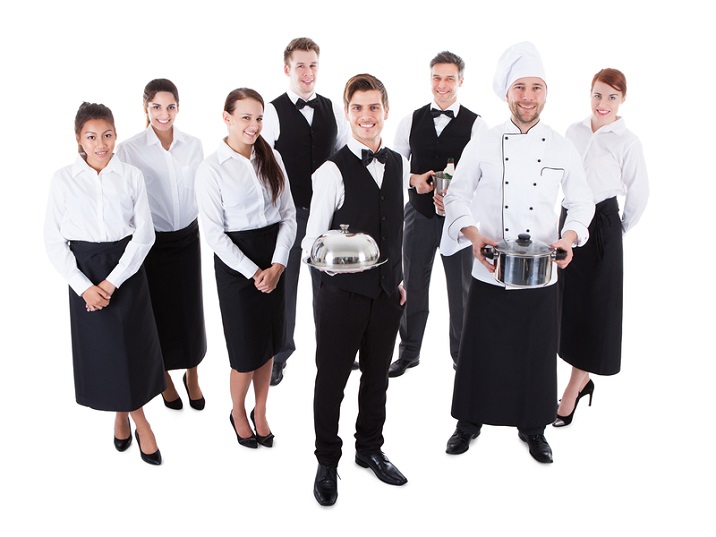
Appearance
It creates the first impression on the guests. The F&B staff members must maintain personal hygiene, cleanliness, and professional appearance while being on duty.
Attentiveness
Attentiveness is paying sincere attention to details, memorizing the guests’ needs and fulfilling them timely with as much perfection as one can put in.
Body Language
The F&B Services staff needs to conduct themselves with very positive, energetic, and friendly gestures.
Effective Communication
It is very vital when it comes to talking with co-workers and guests. Clear and correct manner of communication using right language and tone can make the service workflow smooth. It can bring truly enhanced experience to the guests.
Punctuality
The F&B Services staff needs to know the value of time while serving the guests. Sincere time-keeping and sense of urgency helps to keep the service workflow smooth.
Honesty and Integrity
These two core values in any well-brought-up person are important for serving the guests in hospitality sector.
Subscribe to:
Comments (Atom)






